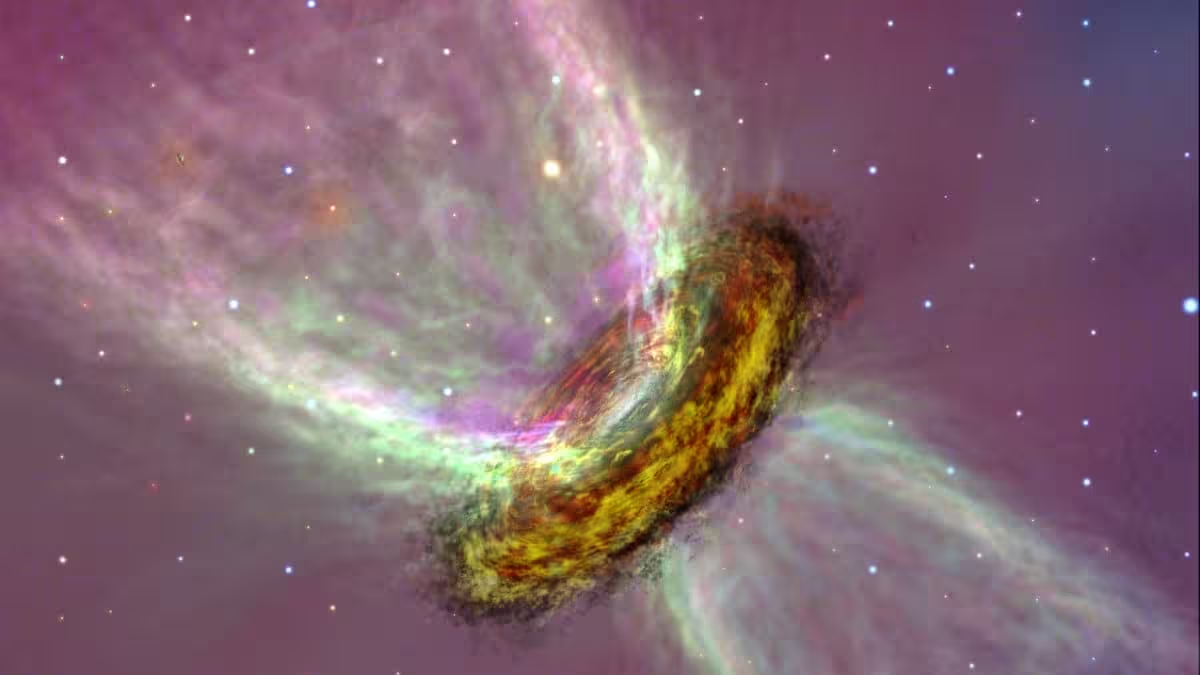Disc winds reveal secrets of planet formation
- October 9, 2024
- 0
With the help of the infrared space observatory “James Webb”, an international group of astronomers discovered a complex structure of disk winds, which are gas flows emerging from
With the help of the infrared space observatory “James Webb”, an international group of astronomers discovered a complex structure of disk winds, which are gas flows emerging from

With the help of the infrared space observatory “James Webb”, an international group of astronomers discovered a complex structure of disk winds, which are gas flows emerging from the proto-planetary disk of young stars. The discovery provided new data about the origin of star systems. More than 3000 stars are born every second in the observable universe. Many are surrounded by protoplanetary disks (rotating clouds of gas and dust from which planets form). However, the formation processes of stars and planetary systems are not fully understood.
It is known that the key role in them is played by accretion, which is the accumulation of matter by the star from the surrounding disk. For the gas to stop orbiting around the star and fall on it, it must lose some of its angular momentum, but the exact mechanisms of this process are still unclear.
In recent years, researchers have considered disk winds as a possible explanation. It is believed that winds, driven by magnetic fields and with a speed of 16-80 kilometers per second, carry some of the gas and angular momentum from the disk surface with them.
Authors of the study published in the journal Natural Astronomy, He made observations of four young stars located “at the edge” of the Earth. Three of the four stars have freed themselves from their initial clouds of gas and dust, making them ideal candidates for studying processes inside the disk.
Thanks to the work of the infrared spectrograph NIRSpec (one of the main instruments of the “Webb”) and previously obtained data using the ALMA (Atacama Large Millimeter Array) telescope, astronomers have learned fundamentally new information about the gas flows blown from the planet. -disk creation in space.
The winds were found to have a complex three-dimensional structure: In each disk, a fast, narrow jet stream defined by the emission of iron ions (Fe II) was found immersed in a slower flow of molecular hydrogen (H₂). which was immersed in an even slower flow of carbon monoxide (CO). These different components support theoretical models of the submerged morphology of disk winds.
In doing so, the team obtained the first images of winds contributing to the loss of angular momentum (when gas loses some of its inertia to fall onto the star). The results obtained within the scope of the research help to understand how stars and planetary systems are formed.
Other processes that influence the evolution of protoplanetary disks include flows of material called X winds, which emanate from the protoplanet and arise due to magnetic forces in the accretion disks near the forming star. The outer parts of the disk are also irradiated by intense starlight, causing thermal winds.
“Thanks to the high sensitivity and resolution of the James Webb space observatory, it was possible to distinguish winds, thermal winds and X-winds driven by the magnetic field,” the authors of the new study said.
The results give scientists an idea of what the Solar System might have looked like 4.6 billion years ago. The “submerged” morphology of the winds supports theoretical predictions that disk winds play a key role in material accretion and planet formation.
The team plans to continue observations to better understand the processes occurring in protoplanetary disks and obtain new data about the origins of stellar systems such as the Solar System and potentially habitable worlds beyond.
Source: Port Altele
As an experienced journalist and author, Mary has been reporting on the latest news and trends for over 5 years. With a passion for uncovering the stories behind the headlines, Mary has earned a reputation as a trusted voice in the world of journalism. Her writing style is insightful, engaging and thought-provoking, as she takes a deep dive into the most pressing issues of our time.